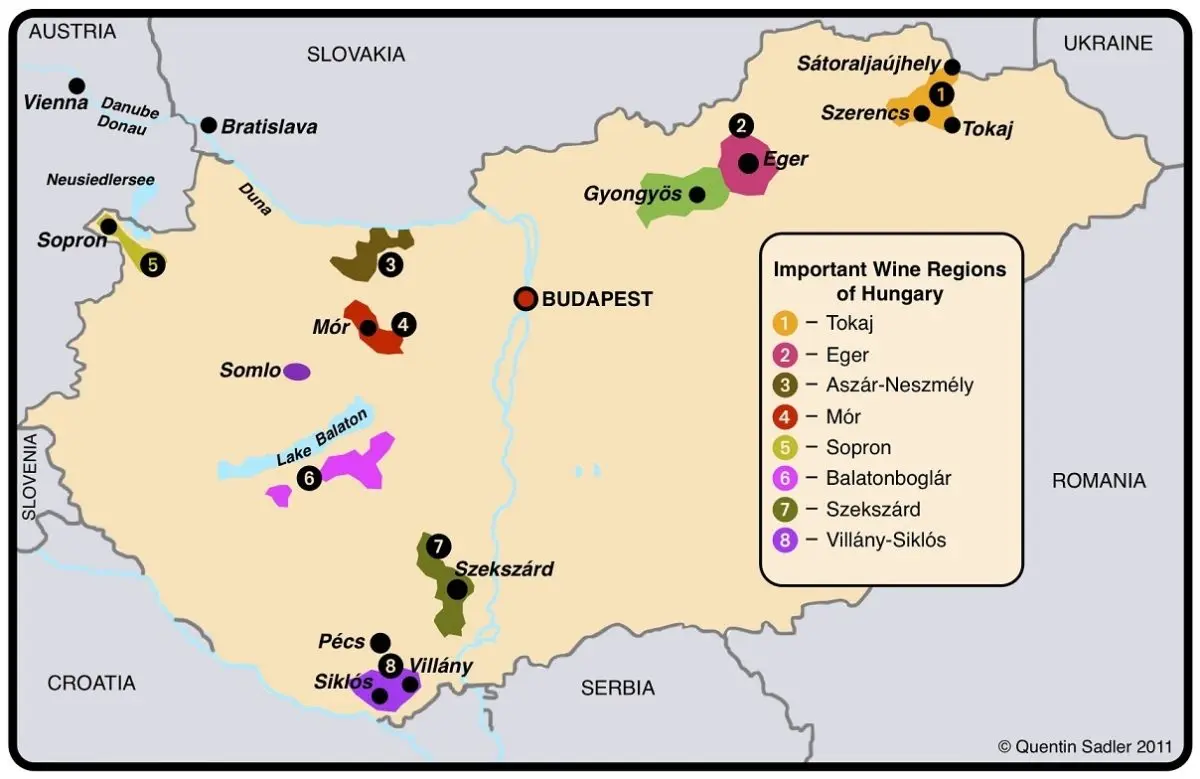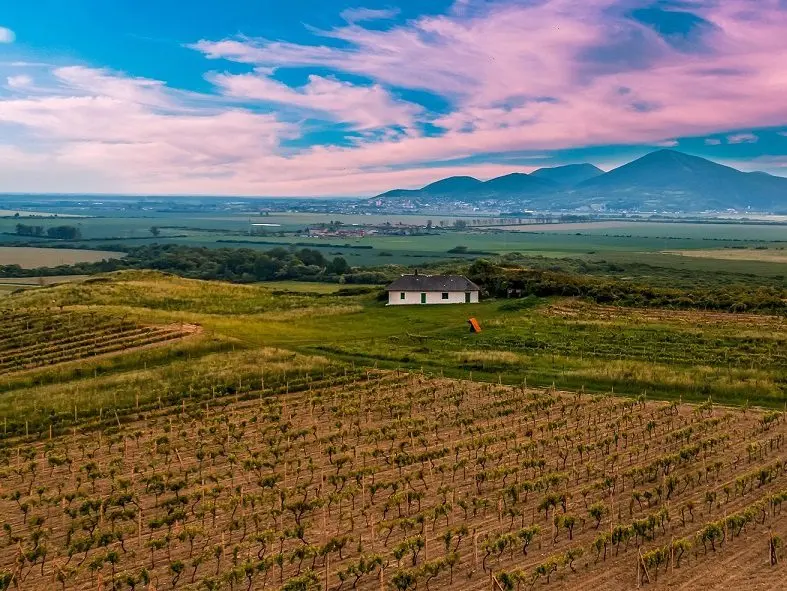Despite the fact that Hungarian wines are slightly less popular than French or German ones, this country boasts amazing samples known all over the world.
History
Just a hundred years ago, Hungary was one of the main European wine producers, and Tokaj was generally considered the drink of kings. The phylloxera epidemic that broke out in Europe in the 1880s put an end to this idyll. This was followed by two World Wars and 40 years of communist collectivization, from which Hungary began to recover only in the 1990s.
Today, the country is home to many small wineries, and thousands of grape varieties grow in 22 regions.
Production regions
The wine-growing regions of Hungary are located between the 46th and 49th parallel – on the same longitude as the French. Local volcanic and limestone soils are very fertile, which contributes to the development of wine production.

If (if)
This terroir is located in the north of the country, about 140 km from Budapest. The region boasts many autochthonous varieties. It was here that scientists found a fossilized vine more than 30 million years old.
Winemaking has always been a significant part of Eger’s income, not least thanks to the monks and monasteries who began producing wine over 1000 years ago. The local economy was so heavily dependent on winemaking that it continued even under Ottoman rule, with the full permission of the Turks.
The region is known for two wines:
one). Egri Bikavér (“Bull’s blood”). This is a full-bodied red wine with high tannin content, high acidity and distinct spicy notes in the bouquet. Also on the palate you can distinguish jam notes, forest fruits and berries.

Legend claims that the wine got its name from a curious incident that took place in 1552, when Hungary was still under the rule of the Ottoman Empire. The Turks caught the Hungarian soldiers drinking plentiful libations, but when they saw bloodshot eyes, beards dripping with red liquid and ferocious faces, they were frightened and rushed to their heels, informing their command that the Hungarians drink bull’s blood.
This wine is made from a blend of varieties. According to the rules, the composition must include at least three different grapes, with 50% must be an autochthonous variety – usually Kékfrankos, although there may be others. A bottle of such wine costs about $15-20, but fakes are often found on the market, so you should be careful.
2). Egri Csillag (“Star of Eger”). This is an aromatic white wine made from a blend of different varieties.
According to legend, in ancient times, travelers who went astray found their way to Eger along the roofs of wineries that shimmered brightly in the light of the stars, and called them “Eger Stars”. This is where the name of the wine comes from.
The composition of the “Star of Eger” must include at least 4 different white varieties, and half of the raw materials certainly fall on autochthonous grapes. For example, it can be Leányka, Királyleányka, Furmint, Hárslevelü and others. The taste of this wine clearly felt notes of white flowers and tropical fruits such as pineapple, lychee, citrus, and the aftertaste reveals nuances of almonds. Egri Csillag is recommended to drink ice-cold, the average price of a bottle is $15.
Tokaj
Even those who do not know anything about the wines of Hungary have definitely heard about the sweet wine Tokaj from the region of the same name – or about its dry analogue Furminte.
As for the soil, clay, loess soil, as well as volcanic soils rich in iron and limestone, prevail here.

Not only is Tokaj the most famous wine region in Hungary, it is the oldest officially recognized appellation in the world, a UNESCO protected area, and the birthplace of the world’s first noble rot wine, Tokaji Aszú.
The region is located between two rivers, creating a unique microclimate: the high humidity of this area is compensated by strong beliefs and an excess of sunlight.
Tokaj (Tokay) – the sweetest white wine from botrytised (infected with noble rot) berries. The drink is made from 6 indigenous varieties: Furmint, Hárslevelü, Kabar, Kövérszölö, Zéta and Sárgamuskotály, and the grapes for it are harvested exclusively by hand. The finished wine has a rich amber-golden color, the sugar content in it reaches 120-180 g / liter, and it can be stored indefinitely without loss of quality and taste.
Candied tangerines and apricots, cinnamon, cloves, honey and nectar are felt in the taste of this unique drink. Surprisingly, this is all combined with a fairly high acidity. Classic Tokay is served with foie gras, cream cheese, lemon cakes. The price per bottle starts at $55.
Louis XIV called Tokay Asa the king among wines and the wine of kings.
Traditionally, the sweetness of this wine is measured in baskets called puttons. The more puttons of grapes used for raw materials, the sweeter the result will be.
Furmint. A dry variation of the famous Tokai wine – made from the same varieties, but from ordinary berries, without noble rot. The drink is dominated by mineral notes, nuances of green apples and wet bark. Depending on the producer, this wine can be similar to Gruner, Chardonnay, Riesling and other white wines. The cost of a bottle varies between $12-20.
Villány
The region is dominated by volcanic soils. Of the autochthonous wines of the region, Kékfrankos can be called, but the main production falls on such well-known and popular wines as Cabernet Franc, Cabernet Sauvignon and Merlot.
Villany is located almost on the border with Croatia and has a warm Mediterranean climate. Summers here are usually long and hot, while winters are short and mild.
The wines of the region are well balanced, with a distinct tannin profile, fruity notes and “earthy” nuances. Hungarian Merlot and Cabernet are often not inferior to their French counterparts, while being much more affordable.

Nagy Somló
Volcanic soils are combined with loess soil, clay and sand.
Somlo is the smallest wine-growing region in Hungary, but it produces unique white wines with a “fiery” and “smoky” taste. Hungarians believe that such a drink can cure almost all diseases, and aristocrats and queens drank wine from Somlo to give birth to a boy.
Juhfark wine deserves special mention, in translation – “sheep’s tail”. This is a sharp drink with a bright and slightly ashy taste, lemon, smoke and wheat are felt in the bouquet, the profile and aftertaste are distinctly mineral.
Interesting Facts
- In most European languages, the word “wine” sounds more or less similar, as it comes from the common Latin ancestor vinum. Hungarian is one of three exceptions, in this language wine is called bor.
- Hungarian oak is one of the three most common wine barrel materials, second only to French and American oak.









